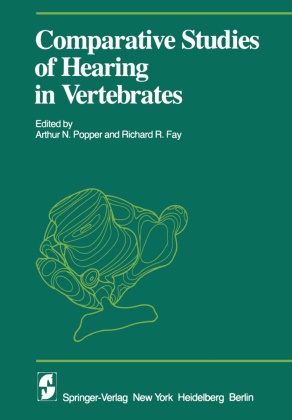En savoir plus
The past two decades have seen an extraordinary growth of interest in the auditory mechanisms of a wide range of vertebrates and invertebrates. Investigations have ranged from auditory mechanisms in relatively simple animals where just a few cells are em ployed for detection of sound, to the highly complex detection and processing systems of man and the other mammals. Of particular significance to us has been the growing interest in general principles of vertebrate auditory system organization, as opposed to a specific and limited concern for the mammalian or even human systems. Some of the interest in nonmammalian systems has risen from the desire to fmd simpler experi mental models for both the essential components (e. g. , the hair cell receptor) and the more complex functions (e. g. , frequency analysis) of all vertebrate auditory systems. Interest has also risen from questions about the evolution of hearing and the covariation (or lack of it) in structure and function in a wide variety of biological solutions to the problems of acoustic mechanoreception. Of course, the desire to fmd simpler experi mental models and the need to answer questions about the evolution of hearing are not unrelated. In fact, detailed analyses of a variety of systems have led several times to the realization that some of the "simple systems" are more complex than initially thought.
Table des matières
I Fishes.- 1 Structure and Function in Teleost Auditory Systems.- 2 Underwater Localization-A Major Problem in Fish Acoustics.- 3 Central Auditory Pathways in Anamniotic Vertebrates.- II Amphibians.- 4 The Structure of the Amphibian Auditory Periphery: A Unique Experiment in Terrestrial Hearing.- 5 Nonlinear Properties of the Peripheral Auditory System of Anurans.- III Reptiles.- 6 The Reptilian Cochlear Duct.- 7 Physiology and Bioacoustics in Reptiles.- IV Birds.- 8 Structure and Function of the Avian Ear.- 9 Behavior and Psychophysics of Hearing in Birds.- 10 Sound Localization in Birds.- 11 Response Properties of Neurons in the Avian Auditory System: Comparisons with Mammalian Homologues and Consideration of the Neural Encoding of Complex Stimuli.- PartV Mammals.- 12 Directional Hearing in Terrestrial Mammals.- 13 Comparative Organization of Mammalian Auditory Cortex.- 14 Man as Mammal: Psychoacoustics.- 15 The Evolution of Hearing in the Mammals.- VI Future View.- 16 Comparative Audition: Where Do We Go from Here?.
Résumé
The past two decades have seen an extraordinary growth of interest in the auditory mechanisms of a wide range of vertebrates and invertebrates. Investigations have ranged from auditory mechanisms in relatively simple animals where just a few cells are em ployed for detection of sound, to the highly complex detection and processing systems of man and the other mammals. Of particular significance to us has been the growing interest in general principles of vertebrate auditory system organization, as opposed to a specific and limited concern for the mammalian or even human systems. Some of the interest in nonmammalian systems has risen from the desire to fmd simpler experi mental models for both the essential components (e. g. , the hair cell receptor) and the more complex functions (e. g. , frequency analysis) of all vertebrate auditory systems. Interest has also risen from questions about the evolution of hearing and the covariation (or lack of it) in structure and function in a wide variety of biological solutions to the problems of acoustic mechanoreception. Of course, the desire to fmd simpler experi mental models and the need to answer questions about the evolution of hearing are not unrelated. In fact, detailed analyses of a variety of systems have led several times to the realization that some of the "simple systems" are more complex than initially thought.

